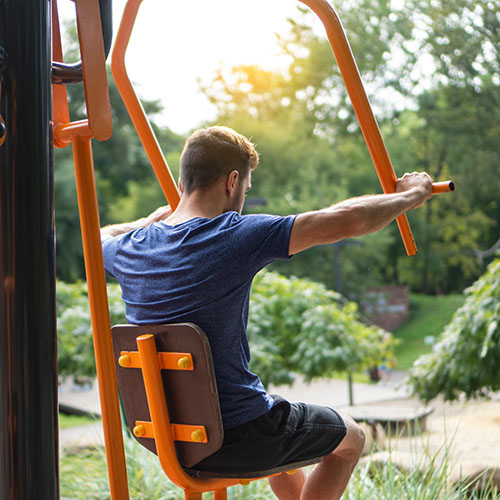17 July 2023
 We all know exercise is good for us, but when times are tough, a fitness membership is often out of the question. Now, new research from the University of South Australia aims to boost community use of outdoor fitness equipment in a move to increase community activity and wellbeing.
We all know exercise is good for us, but when times are tough, a fitness membership is often out of the question. Now, new research from the University of South Australia aims to boost community use of outdoor fitness equipment in a move to increase community activity and wellbeing.
Funded by Wellbeing SA*, researchers audited outdoor fitness equipment in 34 out of 46** South Australian council areas and identified factors that might motivate or deter people from using them.
Physically inspecting and undertaking a comprehensive review of 169 of 202 sites (84% of identified sites) researchers found that 72% were in good condition, 70% featured soft-fall foam under the equipment, 72% had seating, and 82% were next to playgrounds.
Yet they also found that 51% had no drinking fountains, 63% had no access to public toilets, and 49% did not have adequate shade. Researchers also identified potential safety issues, with only 21% of outdoor fitness sites having lighting nearby.
UniSA researcher Dr Alyson Crozier says findings from the state-wide project will support councils to better promote and maintain safe and user-friendly outdoor fitness sites.
“Keeping active is essential for good health. Not only does it help improve physical and mental health, but it also improves our wellbeing and quality of life,” Dr Crozier says.
“Outdoor fitness equipment is great because it is freely accessible to the community and provides a unique opportunity for people to exercise outdoors, with families and people within the neighbourhood.
“But given the wide range of potential users, it’s important that the equipment provided are appropriate and sites are safe.
“Having well-maintained equipment with clear user instructions is essential, but equally so is ensuring that outdoor sites are located in accessible, well-lit, and high-foot traffic areas, which is important from a personal safety perspective
“Adding shade or shelters to sites in open areas will also help protect people from the elements – enabling them to exercise rain or shine – and making sure the sites have drinking fountains, and amenities such as toilets, seating and disability access is also important.”
The study also indicated that to encourage more people to use the outdoor fitness sites, councils will need to consider additional signage and communication tools.
“Outdoor fitness sites are great for those in the know, but to increase the number of people in a community using these spaces, we need to ensure they know about them,” Dr Crozier says, “So, things like additional signage, websites, icons on maps and apps would certainly help.
“Supervised sessions that encourage people to come and try outdoor fitness equipment may also be useful and a good way to bring communities together for a positive experience.
“Projects like this showcase how small adjustments to the promotion of public areas have the potential to create positive change in local communities. It’s another step forward to boosting community health and wellbeing.”
Notes to editors:
* This initiative is aligned with the https://www.wellbeingsa.sa.gov.au/our-work/healthy-places-people/healthy-parks-healthy-people and the Physical Activity in Nature Action Plan.
** South Australia has 68 councils, but 23 councils do not appear to have outdoor fitness equipment sites.
……………………………………………………………………………………………………………………
Media contact: Annabel Mansfield M: +61 479 182 489 E: Annabel.Mansfield@unisa.edu.au
Researcher: Dr Alyson Crozier E: Alyson.Crozier@unisa.edu.au



